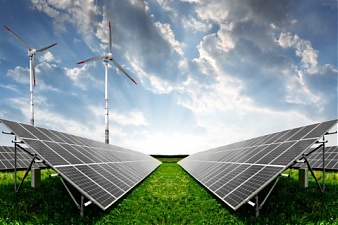Ecology, Energy, Estonia
International Internet Magazine. Baltic States news & analytics
Thursday, 15.01.2026, 19:01
Renewable electricity accounts for over 37% electricity produced in Estonia in Q3
 Print version
Print version |
|---|
Power plants in Estonia produced 494 gigawatt-hours of renewable energy in the third quarter, 15% more than during the same period the year before, transmission system operator (TSO) Elering said.
In 2019, the share of renewable electricity in total electricity consumption was 21%. According to the previously set target, renewable electricity in Estonia was to cover at least 17.6% of consumption in 2020 and the target for 2030 is to cover at least 30% of electricity consumption.
The increase in the amount and share of renewable energy was supported by good wind conditions and somewhat reduced electricity consumption in the previous quarter. Wind energy accounted for a third of total renewable energy production in the third quarter and the produced amount of 141 gigawatt-hours was 13% higher than last year.
Renewable energy subsidies were paid out to producers in the total sum of 22.7 million euros from June to August, 19% more than during the same period last year.
In the third quarter, 79% of wind energy was subsidized and the amount of the support reached 6 million euros. In the first nine months of the year, the payments made therefore come to 81% of the maximum subsidized yearly amount of 600 gigawatt-hours of wind energy.
Electricity produced from biomass, biogas and waste made up 61% of the production of renewable energy in the last three months. A total of 302 gigawatt-hours of electricity was generated from these types of fuel during the summer months and some 14 million euros in support was paid. Both the production volume and subsidy were approximately at the same level as during the same period last year, there has been a slight reduction in the production of electricity from biogas, which has been replaced by natural gas.
A total of 3 GWh of hydro energy was produced during the quarter and 96,000 euros was paid out in subsidies on hydro energy.
The number of subsidized solar panel owners continued to increase quickly, as expected, and there are already some 4,000 producers of electric energy receiving support. The amount of solar energy transferred to the grid in the third quarter totaled close to 50 GWh. Thanks to additional solar panels, this figure has doubled compared to last year.
Support for efficient co–generation totaled 136,000 euros in the third quarter with altogether 4 GWh of electricity produced.
Electricity consumers finance the support for renewable energy and efficient co-generation by means of the renewable energy charge. Elering collected a total of 65.4 million euros of this charge in the first nine months of the year. Renewable energy subsidies paid out to producers totaled 74.2 million euros.
In the middle of the year, the government decided to allocate 4 million euros to the payment of subsidies in order to avoid an increase in consumer tariffs.
- 29.12.2020 Linde Gas открывает завод в Кедайняйской СЭЗ
- 29.12.2020 Number of new companies registered in Estonia up in 2020
- 28.12.2020 Рынок недвижимости Эстонии осенью начал быстро восстанавливаться
- 28.12.2020
- 28.12.2020 Tartu to support students' solar car project
- 28.12.2020 Owner of Kunda Nordic Tsement to install full-scale CCS facility in Norway
- 23.12.2020 В 2019 году выросли прибыль и оборот Eesti Pagar
- 23.12.2020 Flying Forward 2020 starts developing air mobility of cities
- 22.12.2020 The Baltic PMs summed up the results of 2020
- 22.12.2020 Movement of parcels between Estonia, UK suspended until New Year; Lithuanian Post warns of delays








 «The Baltic Course» Is Sold and Stays in Business!
«The Baltic Course» Is Sold and Stays in Business!

